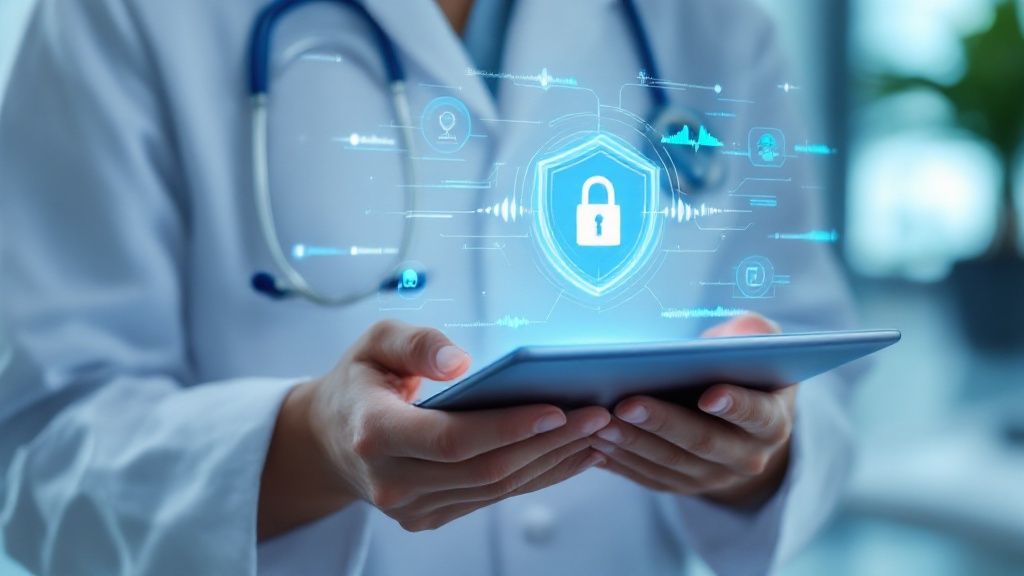A HIPAA-compliant AI scribe is a specialized software tool that securely listens to conversations between healthcare providers and their patients, then automatically drafts clinical notes. Crucially, it is engineered from the ground up to adhere to the stringent privacy and security regulations of the Health Insurance Portability and Accountability Act (HIPAA), ensuring all patient data remains confidential and protected.
The End of Endless Charting: The Rise of AI Scribes

For too many clinicians, the day doesn't end when the last patient goes home. It drags on for hours, filled with the soul-crushing administrative work we all call "pajama time." This mountain of charting is a well-known cause of physician burnout, turning passionate healers into data-entry clerks and eroding the work-life balance that is essential for sustainable, high-quality care.
This guide is about the solution that's finally making a real difference: the HIPAA-compliant AI scribe. This isn't just another dictation app. It’s a sophisticated, intelligent assistant designed specifically for the messy, fast-paced, and highly regulated reality of modern healthcare. It represents a technological leap forward, moving beyond simple transcription to intelligent, context-aware documentation.
A Partner in Patient Care
A simple recording device just captures sound; it creates a raw, unstructured audio file. An AI scribe, on the other hand, is designed to understand the context of a clinical conversation. It employs advanced Natural Language Processing (NLP) models to distinguish between medically relevant information—symptoms, medications, diagnoses, treatment plans—and the friendly small talk that builds patient rapport. The output is not a transcript but a clean, structured clinical note, ready for a quick review and signature.
Imagine an assistant that instantly captures the key details of an exam, organizes them into a perfect SOAP note, and has it waiting in the EHR for your approval. That’s what a good AI scribe does.
This technological assistance frees you up to look your patient in the eye, build trust, and focus on them instead of a screen. The "HIPAA-compliant" part is the most important piece of the puzzle. It’s your guarantee that all this new efficiency doesn't risk patient privacy. Security is baked into its DNA, ensuring every function and data transfer adheres to federal law.
In this guide, we'll walk through everything you need to know about HIPAA-compliant AI scribes, including:
- How these tools handle protected health information (PHI) safely.
- The must-have features to look for when you're evaluating options.
- The real benefits for your practice, your staff, and your patients.
- A practical roadmap for bringing one into your workflow.
By the time you're done, you'll see exactly how this technology can help you get back to practicing medicine and leave the paperwork behind.
How AI Scribes Securely Handle Patient Data

A genuinely HIPAA-compliant AI scribe is more than just a smart microphone. Think of it like a digital fortress, built from the ground up with layer after layer of defense to keep sensitive patient information locked down. This isn't just about recording a conversation; it's about a complete security architecture that protects Protected Health Information (PHI) at every single step, from initial capture to final storage.
The process kicks off the second the AI begins listening to the natural conversation between you and your patient. The software captures the audio, but it doesn't just send a raw file across the internet. Instead, it immediately scrambles the data using end-to-end encryption, a powerful security protocol that makes the information completely unreadable to any unauthorized party during transit.
From there, the AI’s Natural Language Processing (NLP) gets to work, figuring out the context of the discussion. It smartly pinpoints the medically important stuff—symptoms, diagnoses, treatment plans—while tuning out the small talk. This information is then organized into a clean, structured clinical note, ready for you to review within a secure, access-controlled platform.
The Core Security Layers Explained
Real compliance is a continuous effort, not a set-it-and-forget-it feature. The best AI scribe platforms are built around a tough security framework where several key components work in tandem to protect data from the moment it's captured until it's archived. This holistic approach ensures there are no weak points in the data lifecycle.
This framework relies on a few non-negotiable safeguards:
- Access Controls: This is about putting strict permissions in place so only authorized clinicians and staff can touch patient data. Robust systems use role-based access control (RBAC), meaning a medical assistant might only be able to view certain parts of a note while the physician has full editing rights. Every click and view is logged, creating a crystal-clear audit trail that shows who accessed what, and when.
- Secure Cloud Infrastructure: Your data isn't just stored on any server. It lives in HIPAA-compliant cloud environments (like AWS, Google Cloud, or Microsoft Azure with specific HIPAA configurations) that meet incredibly high standards for physical security, network design, and continuous threat monitoring. These data centers are fortresses in their own right.
- Business Associate Agreements (BAA): This is the legal handshake between you and the vendor. A BAA is a binding contract that holds the AI scribe company responsible for protecting PHI according to HIPAA’s rules, making them a true partner in your compliance. Without a signed BAA, a vendor is not HIPAA compliant, regardless of their technology.
A HIPAA-compliant AI scribe doesn’t just promise security; it proves it through transparent, verifiable measures. This includes everything from data encryption at rest and in transit to regular security audits and employee training.
Proactive Defense and Modern Protocols
Beyond the basics, the leading systems use even more advanced security measures. Some use what's called "edge processing," where the audio is analyzed right on your local device (like a smartphone or workstation) instead of being sent to the cloud first. This simple step dramatically cuts the risk of the data being intercepted while in transit, as only the processed, de-identified or essential text data might be sent for further refinement.
Of course, prevention is only half the battle. Being prepared for the worst-case scenario is just as critical. A key part of protecting patient data involves developing a robust data breach response plan. Having a clear, actionable strategy ready to go ensures your practice is prepared for anything, giving you a truly complete security posture.
What to Look For in a Top-Tier AI Scribe

Let's be clear: not all AI scribes are built the same. While lots of tools can turn speech into text, a truly effective, HIPAA-compliant scribe needs a specific set of features that actually make a clinician's life easier and more secure. A tool that fails to integrate smoothly or requires constant correction only adds another layer of administrative burden.
Think of this as your practical checklist. We're not just looking for a recorder; we're looking for a genuine clinical partner that can fundamentally improve your workflow, reduce burnout, and enhance the quality of patient care.
Ambient Listening That Just Works
The best technology is the kind you forget is even there. Ambient listening is what allows an AI scribe to capture the natural back-and-forth of a patient visit without being a distraction. It's meant to be a silent partner, working in the background to document the important details while you remain fully engaged with your patient.
No more awkward pauses to dictate notes. No more fumbling to start and stop a recording. The AI is simply on, quietly separating the medically relevant information from the small talk. This frees you up to maintain eye contact and give the patient your full attention, which is exactly where it should be. The technology should be smart enough to handle interruptions, multiple speakers, and varying audio conditions without missing a beat.
Automated and Intelligent Summarization
Getting a raw transcript of a visit is one thing, but the real value is in the summary. A great AI scribe doesn't just listen; it understands. It uses smart algorithms to draft concise, structured clinical notes automatically, often in standard formats that are immediately useful.
This is a massive time-saver. Instead of trying to piece together a SOAP (Subjective, Objective, Assessment, and Plan) note from memory, you get a clean, organized draft ready for a quick review. Many platforms even let you customize the templates to fit your specialty or personal preferences. When you start exploring different medical scribe software options, you'll see just how sophisticated these summarization features can get, often extracting specific data points like medications, dosages, and follow-up instructions.
The real test? An AI scribe should produce a note so accurate and relevant that it feels like a seasoned human scribe was in the room with you, capturing exactly what you needed with minimal edits.
Seamless EHR Integration
This might be the most important feature of all. Without a direct, seamless Electronic Health Record (EHR) integration, an AI scribe creates more problems than it solves. True integration means the tool can securely and automatically push the final note directly into the correct patient's chart with a single click.
This single feature closes the documentation loop. It gets rid of the soul-crushing, error-prone task of copying and pasting text between systems. A solid EHR connection ensures the data is accurate, the risk of manual mistakes plummets, and the note is immediately ready for billing and continuity of care. It’s what turns the AI scribe from a neat gadget into a non-negotiable part of the clinical workflow.
To put it all together, here’s a quick breakdown of the features that separate a basic transcription tool from a true clinical assistant.
Essential Features of HIPAA Compliant AI Scribes
| Feature | Clinical Benefit | HIPAA Compliance Impact |
|---|---|---|
| Ambient Listening | Allows for natural conversation and improved patient-provider connection without workflow interruptions. | Ensures only necessary audio is captured and processed within a secure environment, minimizing data exposure. |
| Intelligent Summarization | Drastically reduces manual documentation time by auto-generating structured notes (e.g., SOAP format). | Processes Protected Health Information (PHI) to create summaries, requiring strong algorithms and data handling protocols. |
| EHR Integration | Eliminates manual data entry, reduces errors, and ensures notes are immediately available in the patient record. | Requires a secure, encrypted connection (API) to the EHR system, often through a Business Associate Agreement (BAA). |
| High Accuracy | Produces reliable and clinically relevant notes that require minimal editing, building trust in the system. | Inaccurate PHI is a data integrity risk. High accuracy is essential for patient safety and compliant records. |
| Customizable Templates | Allows providers to tailor note formats to their specific specialty, workflow, or personal preferences. | Ensures that the PHI is structured correctly and consistently, which aids in accurate auditing and record-keeping. |
Ultimately, a great AI scribe isn't just about the technology itself—it's about how that technology fits into the complex, high-stakes world of healthcare. These core features ensure it's a help, not a hindrance.
The True Impact on Your Practice and Patients
Bringing a HIPAA-compliant AI scribe into your practice isn't just about installing new software—it fundamentally changes the rhythm of a clinical day. The most immediate and powerful result? You get your time back. By taking over the heavy lifting of documentation, this technology is a direct solution to the administrative overload that’s a major driver of clinician burnout.
This reclaimed time creates a ripple effect that benefits everyone. Most importantly, it completely transforms the patient encounter. Instead of dividing your attention between the person in front of you and a computer screen, you can be fully present. You can make eye contact, actively listen, and build the kind of trust that is the absolute bedrock of quality care. This shift from data entry clerk back to dedicated healer is one of the most profound benefits of the technology.
A Day Transformed: Before and After an AI Scribe
Think about a typical day for a busy physician, let's call her Dr. Evans. Before using an AI scribe, her Tuesdays were a blur. She’d see a patient, then immediately spend the next seven minutes furiously typing notes, trying to recall every critical detail while the next patient was already waiting. Her day didn’t end at the clinic; it followed her home as "pajama time"—another two hours of charting that stole time from her family and personal life. This chronic administrative burden led to fatigue and a decreased sense of professional fulfillment.
Now, with an AI scribe, her Tuesday is a different story. During each visit, she focuses entirely on her patient, having a real, natural conversation. The AI scribe works quietly in the background, drafting a clean, accurate SOAP note. Between appointments, Dr. Evans spends just a minute or two reviewing and signing off on the note, which is then automatically pushed to the EHR. She leaves work on time, with her work actually done. The mental space freed up allows her to think more deeply about complex cases and recharge for the next day.
The real impact isn't just finishing charts faster; it's about restoring the human connection in medicine. When providers are less burdened, they can offer more empathetic, focused, and effective care.
This kind of efficiency brings real, measurable improvements. Studies show that a HIPAA-compliant AI scribe can reduce documentation burdens by 20% to 30%, which directly boosts clinician well-being and frees up capacity for more patient care. This time can be reinvested into seeing more patients, spending more time with complex cases, or simply ending the day at a reasonable hour.
Better Data and a Stronger Bottom Line
The benefits don’t stop there. When documentation is completed faster and more accurately, billing cycles can start sooner, which is a straightforward boost to the practice's revenue flow. Coders receive complete, structured notes immediately, reducing delays and claim denials.
Plus, the detailed and structured data captured by the AI creates a much richer, more reliable clinical record. This high-quality data is invaluable for everything from tracking patient outcomes and participating in research to simply making better-informed decisions for future care. It strengthens compliance efforts and provides a clearer picture of population health trends within your practice.
Ultimately, better notes and more present clinicians lead to happier, more engaged patients. As you consider what AI scribes can do for your clinic, remember how much a patient's digital perception matters. For a deeper dive, explore comprehensive reputation management strategies for healthcare providers. This technology doesn't just change a workflow; it elevates the entire standard of care.
How to Choose and Implement an AI Scribe
Bringing a HIPAA-compliant AI scribe into your practice isn't just a software purchase; it's a strategic shift in your entire clinical workflow. Getting it right takes a clear plan—you have to pick the right partner first, then bring the technology into your daily operations thoughtfully. Nail these two steps, and you’ll unlock the real power of this technology.
Don't rush this decision. Vetting potential vendors is the first and most critical hurdle. You aren't just buying a tool; you're bringing on a partner and trusting them with your patients' Protected Health Information (PHI). That means you have to dig deep into their security, compliance, and technological capabilities.
Vetting Your AI Scribe Vendor
Before you sign any contracts, you need to do your homework. Think of it as a due diligence process. You're verifying every claim the vendor makes and making absolutely sure their solution fits your practice like a glove. This goes beyond a simple demo; it involves a thorough investigation of their infrastructure and policies.
Your checklist should treat these items as non-negotiable:
- Robust HIPAA Security: Don't just accept a "HIPAA compliant" badge on a website. Ask for the nitty-gritty details on their data encryption (both for data in transit and at rest), see their access control policies, and request their latest security audit reports or certifications (like SOC 2 Type II).
- A Clear Business Associate Agreement (BAA): A BAA is a legal must-have. Read it carefully to understand exactly how your data will be handled, stored, and protected. It should explicitly state that the vendor won't use your PHI to train their models without your direct consent and detail their breach notification procedures.
- Specialty-Specific Accuracy: An AI scribe that’s great for a family doctor might struggle with the specific language of cardiology or orthopedics. Ask for accuracy stats for your specific medical specialty and make sure their AI has been trained on the terms you use every day. Request a trial to test its performance with your own accent and terminology.
- Seamless EHR Integration: This one is a deal-breaker. The AI scribe has to plug directly and securely into your Electronic Health Record system. The ins and outs of EMR system integration can be complex, but getting it right is the key to a workflow that actually flows. Confirm that they support your specific EHR and understand the implementation process.
Driving Successful Implementation and Adoption
Once you've picked your vendor, the real work begins. A successful rollout is less about the tech itself and more about the people who will use it. The goal is to make the transition so seamless that your team can't imagine ever going back to the old way of doing things. Change management is key.
The good news is that clinicians are more than ready for this change. Physician use of health AI tools, including scribes, nearly doubled from 38% in 2023 to 66% in 2024. This huge jump shows just how much demand there is for solutions that finally lighten the administrative load. In fact, some institutions report up to 90% of primary care physicians requesting access to these tools.
To ride that wave of enthusiasm, follow a structured plan:
- Launch a Pilot Program: Start small. Pick a handful of enthusiastic clinicians to be your champions. Their early success and positive stories will build momentum and help you iron out any wrinkles before you go practice-wide. This also allows you to refine workflows in a controlled environment.
- Provide Comprehensive Training: Don’t just show your staff the "on" button. Train them on the entire new workflow—how to review and edit the AI-generated notes, how to handle patient consent, and what to do when they run into a common issue. Ongoing support and Q&A sessions are vital.
- Establish a Feedback Loop: Give users a simple, direct way to report problems and offer suggestions. A good feedback channel lets you fine-tune the process and shows your team that their voice matters. Use this feedback to work with your vendor on improvements and customizations.
A successful implementation isn’t just about installing software; it’s about redesigning a core clinical process. By setting clear expectations and supporting your team, you can ensure the AI scribe becomes an indispensable asset, not another technological hurdle.
Answering Your Top Questions About AI Scribes
Adopting any new technology in a medical practice, especially one that handles patient conversations, is a big step. It’s only natural to have questions about how it all works. For anyone looking into a HIPAA-compliant AI scribe, getting straight answers on privacy, accuracy, and workflow is crucial.
Let's walk through the most common concerns we hear from clinicians to give you a clear picture of how these tools operate in a real-world setting.
How Do You Get Patient Consent to Record a Visit?
This is a big one, and it's non-negotiable. Getting patient consent is an absolute must, and any well-designed AI scribe system builds this process right into the workflow so nothing gets missed. Transparency is paramount for maintaining patient trust.
It’s usually handled in a couple of simple ways. A clinician might start the visit with a quick, clear verbal confirmation, letting the patient know a secure AI assistant will be helping with the notes. Other times, it's a simple checkbox in the EHR or a line item on the standard patient intake forms. Many practices also post clear signage in exam rooms. The key principle is always transparency—the patient knows what's happening and agrees to it before any recording starts. This keeps everything above board, both ethically and legally.
How Accurate Is the Scribe with Medical Terms and Accents?
This is where a good AI scribe really shines. These aren't just your standard voice-to-text apps; they are specialized platforms trained on enormous datasets packed with medical information. We’re talking about a massive library of medical terms from dozens of specialties, plus a huge range of accents and speech patterns.
The best systems go even further. Many have features that allow the AI to actually learn a specific provider's voice, speaking style, and go-to phrases over time. The more you use it, the smarter and more accurate it gets.
You can also typically add a custom dictionary. This is perfect for niche terminology, acronyms, or specific drug names you use all the time. It fine-tunes the AI to your exact needs, whether you're in cardiology, orthopedics, or psychiatry.
What if the AI Note Contains an Error?
Think of the HIPAA-compliant AI scribe as a hyper-efficient assistant, not the final decision-maker. It’s there to create a solid first draft of the note incredibly fast, but the clinician always, always has the final say. The provider remains the ultimate authority on the patient's record.
This "human-in-the-loop" approach is a core safety feature. Every note the AI generates has to be reviewed, edited if needed, and signed off by the provider before it ever gets saved to the EHR. This system gives you the speed of AI while ensuring the final record has the full weight of your clinical expertise and accountability behind it. It's the ideal partnership of technology and human oversight, guaranteeing 100% clinical accuracy.
Is Our Patient Data Used for AI Training?
This is probably the most critical privacy question, and any reputable company will give you a firm, clear answer. A trustworthy, HIPAA-compliant AI scribe will have strict data-use policies spelled out in your Business Associate Agreement (BAA).
Here’s the bottom line: your practice's identifiable patient data is never used to train public AI models. Period. If a vendor does any model improvement, it's done with completely de-identified, aggregated data, and even then, only with your explicit, opt-in permission. You should always have total control and the ability to say no to any data sharing for training. Your patients' privacy is paramount.
Ready to reclaim your time and focus on what truly matters—your patients? Simbie AI offers a clinically-trained, HIPAA-compliant voice AI platform that automates administrative tasks, from patient intake to scheduling and documentation. Discover how you can reduce burnout and enhance care.

